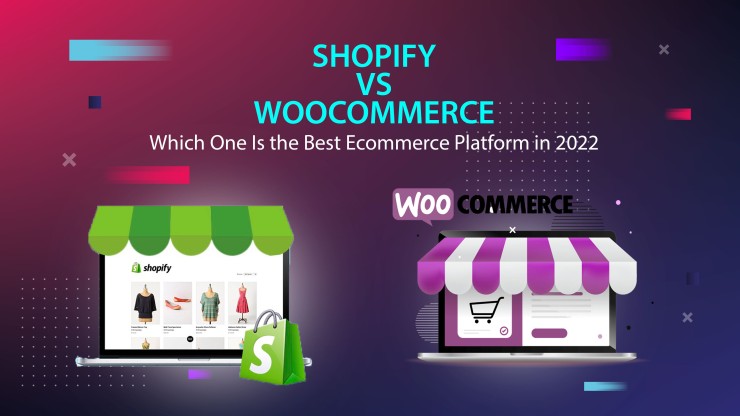An overview with WooCommerce & Shopify:
WooCommerce is a free or open-source eCommerce plug-in for WordPress CMS that helps you build a powerful eCommerce store.
On the other hand, Shopify is a paid source eCommerce platform with many ready-made plug-ins and the latest features. User feedback suggests that Shopify is much easier to use.
According to Google Trends, both WooCommerce and Shopify have steady growth, however, Shopify has a little hike over WooCommerce.
Let’s discuss a few points on which you can choose a platform for your own:
1. At The Starter Level:
WooCommerce is easy to learn and access and you will be at an advantage if you know WordPress. The only difference is if you have WordPress already, you have to install and maintain WooCommerce yourself. In the case of hosting your store, it has its own WooCommerce hosting.
On the other hand, Shopify is a platform that is so simple to use that you can build your eCommerce website on it without having any technical knowledge. However, Shopify support walks you through each step from the start.
2. Third Party Integration:
You would require a lot of tools to integrate with your site for different functioning like sending emails, maintaining stocks automatically, making sakes accounts, social media publications, Search engine optimizations etc. In both cases you have to implement third-party integrations additionally, however, WooCommerce has some common inbuilt scopes with a few integrations like Mailchimp, Product Add-on, Print Invoices, PayPal Payments, Amazon Pay etc.
3. Hosting Options:
Both platforms have their own hosting facilities. WooCommerce site can be hosted from WooCommerce Hosting for free whereas a Shopify site can be hosted on its own server against payment with different suitable plans. However, Shopify has an unlimited storage facility offered to all their hosted sites. A domain name that was chosen during the purchase can be offered in both scenarios.
4. Customization:
WooCommerce does not have its own themes for UI integration. However, you can find themes compatible with it from a common marketplace like ThemeForest or so. There are over 60 pre-built themes for Shopify, some of which are free and some of which are paid, but there are very few editing options available for full customization. Hence, WooCommerce has more customization facilities for the themes with backend programming. Though you must select a lightweight responsive theme to customize in both situations.
5. Add-ons/Extensions:
Both platforms have a lot of extensions to extend and modify regular operational tasks like listing, CSV import, order processing, delivery update, payment methods, discounts and coupons, variations, etc. WooCommerce has a lot of free extensions to choose from for different task modifications whereas Shopify has an app store consisting of more than 500 apps among which a lot are payable.
6. Payment Gateways:
WooCommerce has several payment gateway extensions. Among these PayPal and Stripe are free while others like Amazon Payments or Authorize.net are payable. However, you have top payment gateway options for free which will make your eCommerce store up to the mark.
On the other hand, Shopify has a native payment gateway system Shopify Payments with Stripe and all other gateways are payable. Also, Shopify Payments is also available only in the USA, UK, Canada & Australia. You have to affix a paid third-party payment gateway for other countries.
7. Shipping Methods:
For both platforms, you can set up your shipping cost with respect to shipping mode, size and weight, distance, national or international delivery, and others. However, if you want to make the calculation exactly with a definite shipping partner like UPS or FedEx, you have to buy a shipping calculation plug-in for WooCommerce, and for Shopify, you have to buy advanced Shopify plans for integration.
8. User Friendliness:
WooCommerce is a lot easier to use at the basic level. However, if you lack the necessary expertise in order to perform any type of advanced customization, you must contact a developer. The scenario is quite close in the case of Shopify as well. So in both cases if you have to have advanced knowledge for better class customization rather than drag and drop.
9. Search Engine Optimization:
In both cases, you must want to optimize your product page with SEO for sale. In the case of WooCommerce, you already have a free premium SEO plugin Yoast SEO to be installed. Shopify also has great SEO options for your page visualization, however, it has two limitations. One is with Rich Snippets and the other is URLs of pages which both do not carry ideal SEO structures.
10. Dropshipping:
You will find both the platforms are famous for dropshipping while WooCommerce has its own extensions called WooCommerce Dropshipping Extensions with DropshipMe, AliDropship, WooDropship, and YouDroop. Shopify also has its own dropshipping extensions like Spocket, AliOrders, MIIUT, CJDropshipping, etc. Shopify also has the ability to integrate third-party extensions like Ali Express, Oberlo, Printify etc.
11. Cost:
WooCommerce is cheaper than Shopify because it is free. A Shopify store, according to required add-ons, may stand anywhere between $9 to $299. Although WooCommerce is free, there are still costs associated with using it. The monthly hosting cost with club ways may stand at $10 a month. If we also consider the cost of the theme and other required plugins for advance options the total cost may stand around $30 to $300.
12. Easy operations:
WooCommerce can be operated from WordPress dashboard options at the primary level and products can be added from the “Add New” button. Following “Click” & “Publish Now” you can create the setup. After that, appearance can be easily chosen by hovering over appearance and themes. Even third-party paid themes also may be administered here.
Shopify is deemed to be an even better user-friendly platform. It just has a requirement of a few clicks to open it up along with some basic add-ons for primary features. The magic of Shopify is that you have a lot many add-ons for each requirement. The outcome will be easier with more strategically added extensions.
There are also more things to consider. There are likely to be many more factors to contrast and close conflict between the two. Support system, scalability, add-ons, and integrations, among other things.
So and on, from a lot of comparative discussions, we have seen the scale is more or less close to each side and both the platforms have popularity among users. If you want a multilingual eCommerce website that you want to customize yourself completely and turn into a larger website in the future within a limited budget then WooCommerce is the best option for you. If you prefer a simple website over something like this, Shopify is the way to go.
Happy Business!!




